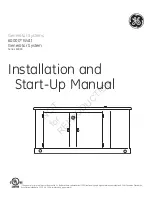
-11-
input terminals on the Inverter. Your cables should be as short
as possible (ideally, less than 10 feet / 3 meters) and large
enough to handle the required current, in accordance with the
electrical codes or regulations applicable to your installation.
Cables that are not an adequate gauge (too narrow) or are too
long will Cause decreased inverter performance such as poor
surge capability and frequent low input voltage warnings and
shutdowns.
These low input voltage warning is due to DC voltage drop
across the cables from the inverter to the batteries. The linger
and narrower these cables, the greater the voltage drop.
I. Operation:
To operate the power inverter, turn it on using the ON/OFF switch
on the front panel. The power inverter is now ready to deliver AC
power to your loads. If you are operating several loads from the
power inverter, turn them on separately after the inverter has been
turned on. This will ensure that the power inverter does not have to
deliver the starting currents for all the loads at once.
I-1. Controls and indicators
The ON/OFF switch turns the control circuit in the power inverter
on and off.
It does not disconnect power from the power inverter.
The Inverter operates from an input voltage ranging from:
10 to 16 VDC for 12V models
20 to 32 VDC for 24V models
42 to 62 VDC for 48V models
Peak performance for these inverter occurs when DC input
voltage is in the Range of 10 volts to 16 volts for 12V models and
20 volts to 32 volts for 24V Models, and 42 volts to 62 volts for
Summary of Contents for PM-0600H
Page 5: ... 4 ...






































